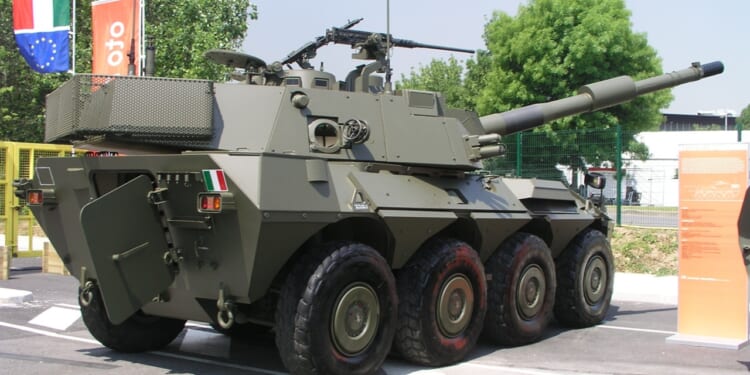The B1 Centauro tank destroyer lacks the armor of a main battle tank—but its tremendous speed allows it to zip in, destroy an opponent, and retreat before others return fire.
Italian-made B1 Centauro wheeled tank destroyers were spotted on the front lines in Ukraine earlier this month, in service with the 78th Separate Assault Airborne Regiment, which was defending the Sumy Oblast in the north of the besieged country. The quick-moving 8×8 wheeled vehicles have been equipped with “anti-drone screens,” which provide some added protection to their lightly armored skin.
Rumors had first circulated in early 2023 that Rome had provided Kyiv with the platform, but it was only confirmed this past March that Italy had agreed to supply an undisclosed number of Centauros to Ukraine.
The B1 Centauro was developed by the Iveco Fiat-OTO Melara (CIO) consortium at the end of the Cold War, with the former overseeing the design of the vehicle’s hull and powerplant, while Oto Melara designed the turret and weapons systems.
The B1 Centauro Is a Tank Destroyer—Not a Tank!
The Centauro has earned comparisons to the French-made 6×6 wheeled AMX-10RC, which Paris has also supplied to Kyiv.
However, where the French military designated the AMX-10RC as a “light tank” that could serve as a reconnaissance vehicle, its Italian counterpart was developed as a “tank destroyer.” The B1 is armed with a 105mm rifled main gun that can fire a variety of NATO-standard rounds, including armor-piercing fin-stabilized discarding sabot (APFSCS) ordnance to a range of 3,000 meters (1.86 miles).
The French AMX-10RC, equipped with a 105mm BK MECA L/47 medium-pressure main gun, has been primarily employed as a self-propelled artillery vehicle, providing indirect fire support. By contrast, the 8×8 B-1 is reportedly being used as a shoot-and-scoot platform on the frontlines.
The Centauro’s V6 turbo-Diesel 520 horsepower engine gives it a top speed of 67 mph (108 km/h), allowing it to take a shot and quickly retreat to a safe position instead of engaging in a slug match with an adversary’s main battle tank (MBT). In such a scrap, the B1 would be seriously outclassed, given that it has only 25mm in front armor—intended to provide protection from light and medium arms, rather than a tank’s main cannon.
The Centauro Is Way Faster than Russian Tanks
Speed, not armor, is the Centauro’s primary defense.
“Militarily, it gives Ukrainian commanders an extra tool: a fast direct-fire element suited for reconnaissance-in-force, rapid reinforcement of threatened sectors, escort of supply columns in contested areas, and ambush of enemy mechanized thrusts from secondary roads,” Army Recognition explained.
As an 8×8 wheeled vehicle, it is lighter than the main battle tanks (MBTs) now in service, and the B1 could also better deal with the fall rains and spring thaws that result in the “time of mud” that have stymied both sides during much of the ongoing war. It is further equipped with a unique steering system, where its first and second axles are steered, along with the fourth axle at low speeds. That gives the Centauro a remarkably small turning radius of just nine meters.
However, unlike Soviet/Russian armored personnel carriers (APCs) and infantry fighting vehicles (IFVs), the Centauro is not designed to be amphibious, giving it a certain limitation during battlefield maneuvers.
Around 500 of the original Centauro models had been produced, and the Italian Army remains the primary operator. Production of the improved Centauro II model, featuring a 120mm main gun, commenced in 2021. It was expected that Rome would provide Kyiv with its earlier variants, which are now on the front lines in Ukraine.
The exact number hasn’t been disclosed, but Kyiv needs every vehicle it can get, as the war has been ongoing for more than three and a half years.
About the Author: Peter Suciu
Peter Suciu has contributed over 3,200 published pieces to more than four dozen magazines and websites over a 30-year career in journalism. He regularly writes about military hardware, firearms history, cybersecurity, politics, and international affairs. Peter is also a contributing writer for Forbes and Clearance Jobs. He is based in Michigan. You can follow him on Twitter: @PeterSuciu. You can email the author: [email protected].
Image: Shutterstock / Flying Camera.

















